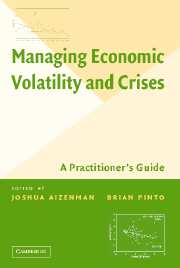Book contents
- Frontmatter
- Contents
- Contributors
- Acknowledgments
- Foreword
- MANAGING ECONOMIC VOLATILITY AND CRISES
- Overview
- PART I WHAT IS VOLATILITY AND WHY DOES IT MATTER?
- PART II COMMODITY PRICES AND VOLATILITY
- PART III FINANCE AND VOLATILITY
- PART IV MANAGING CRISES
- 8 Managing Macroeconomic Crises: Policy Lessons
- 9 Lessons from the Russian Crisis of 1998 and Recovery
- 10 Argentina's Macroeconomic Collapse: Causes and Lessons
- 11 Default Episodes in the 1980s and 1990s: What Have We Learned?
- Technical Appendix
- Index
- References
8 - Managing Macroeconomic Crises: Policy Lessons
Published online by Cambridge University Press: 25 July 2009
- Frontmatter
- Contents
- Contributors
- Acknowledgments
- Foreword
- MANAGING ECONOMIC VOLATILITY AND CRISES
- Overview
- PART I WHAT IS VOLATILITY AND WHY DOES IT MATTER?
- PART II COMMODITY PRICES AND VOLATILITY
- PART III FINANCE AND VOLATILITY
- PART IV MANAGING CRISES
- 8 Managing Macroeconomic Crises: Policy Lessons
- 9 Lessons from the Russian Crisis of 1998 and Recovery
- 10 Argentina's Macroeconomic Collapse: Causes and Lessons
- 11 Default Episodes in the 1980s and 1990s: What Have We Learned?
- Technical Appendix
- Index
- References
Summary
ABSTRACT: This study is an attempt to review broadly what the last decade reveals about which policies for crisis prevention or crisis management seem to work and which do not. The empirical investigation tries out a variety of methodological approaches: reasoning from examples of prominent crises of the last eight years, formal probit analysis, a regression tree analysis, conventional regression analysis, and a look at the typical profile of financing during the sudden stop preceding a crisis.
We seek to draw greater attention to policy decisions that are made during the phase when capital inflows come to a sudden stop. Procrastination – the period of financing a balance of payments deficit rather than adjusting – had serious consequences in some cases. Crises are more frequent and more severe when short-term borrowing and dollar denominated external debt are high, and foreign direct investment (FDI) and reserves are low, in large part because balance sheets are then very sensitive to increases in exchange rates and short-term interest rates.
Our point is that these compositional measures are affected by decisions made by policymakers in the period immediately after capital inflows have begun to dry up but before the speculative attack itself has hit. If countries that are faced with a fall in inflows adjusted more promptly, rather than stalling for time by running down reserves or shifting to loans that are shorter-termed and dollar-denominated, they might be able to adjust on more attractive terms.
In the last 30 years, emerging markets have experienced at least two complete boom-bust cycles.[…]
- Type
- Chapter
- Information
- Managing Economic Volatility and CrisesA Practitioner's Guide, pp. 315 - 405Publisher: Cambridge University PressPrint publication year: 2005
References
- 19
- Cited by



